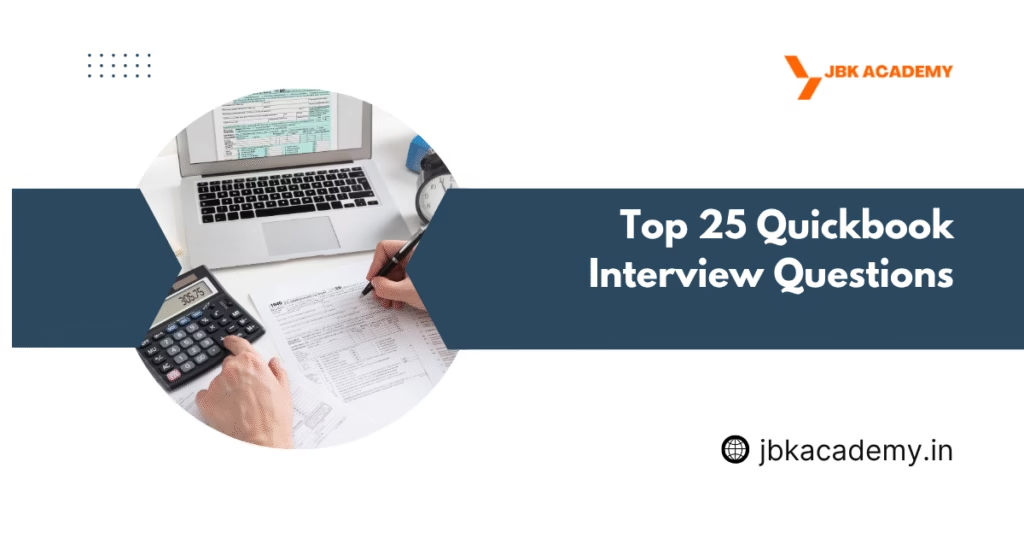Quickbook Interview Questions

QuickBooks is one of the most trusted accounting software solutions for small and mid-sized businesses. Whether you’re applying for a bookkeeping, accounting, admin, or finance role, QuickBooks interview questions are almost guaranteed to come up.
To help you prepare with confidence, we’ve compiled 35 of the most common QuickBooks interview questions, along with clear sample answers. Let’s get you ready to impress any employer!
✅ Basic QuickBooks Interview Questions
What is QuickBooks?
Answer: QuickBooks is accounting software developed by Intuit. It helps businesses manage invoicing, expenses, payroll, tax filing, bank reconciliation, and financial reporting in one place.
What are the different versions of QuickBooks?
Answer: QuickBooks offers Desktop editions (Pro, Premier, Enterprise), QuickBooks Online (cloud-based), QuickBooks Self-Employed (for freelancers), and QuickBooks POS (Point of Sale) for retail businesses.
Which version are you most familiar with?
Answer: Example: I’m most experienced with QuickBooks Online for cloud bookkeeping and QuickBooks Desktop Premier for more complex local setups. I’ve also used QuickBooks Enterprise for large inventory-based businesses.
What industries have you used QuickBooks for?
Answer: Example: I’ve worked with QuickBooks for retail, consulting, non-profits, construction, and professional services. I can customize the Chart of Accounts to fit different industry needs.
What’s the difference between QuickBooks Desktop and QuickBooks Online?
Answer: QuickBooks Desktop is installed locally and has more advanced features like job costing and batch invoicing. QuickBooks Online is cloud-based, accessible from anywhere, automatically updated, and supports real-time collaboration.
✅ Company Setup & Configuration
How do you create a new company file in QuickBooks Desktop?
Answer: Go to File → New Company → Express Start or Detailed Start. Enter your company info, industry, fiscal year, and customize your Chart of Accounts.
How do you set up a Chart of Accounts?
Answer: Go to Lists → Chart of Accounts → Account → New. Choose an account type (income, expense, asset, liability), name it, and add an opening balance if needed.
How do you add or edit users in QuickBooks Online?
Answer: Go to Settings → Manage Users → Add User. Choose the user type and permissions. To edit, click on a user’s name and update their access.
How do you back up and restore a company file?
Answer: In Desktop, go to File → Back Up Company → Create Local Backup. To restore, go to File → Open or Restore Company → Restore a Backup Copy.
How do you set up sales tax in QuickBooks?
Answer: Go to Taxes → Sales Tax → Set up Sales Tax. Add your tax agency, enter the tax rate, and apply it to products/services. QuickBooks will calculate tax automatically on invoices.
✅ Customer & Vendor Transactions
How do you create and send an invoice?
Answer: Go to Customers → Create Invoices. Choose a customer, add products/services, enter amounts and terms, then save and email or print the invoice.
How do you record customer payments?
Answer: Go to Customers → Receive Payments. Select the customer, payment date, method, and amount. Link it to the open invoice.
How do you handle partial payments?
Answer: Enter the amount received in the Receive Payments window. QuickBooks keeps the invoice open for the remaining balance.
How do you enter a bill from a vendor?
Answer: Go to Vendors → Enter Bills. Select the vendor, date, due date, expense or item details, and save.
How do you pay bills in QuickBooks?
Answer: Go to Vendors → Pay Bills. Select the bills to pay, choose the bank account and payment method (check or online payment), and record or print the check.
✅ Banking & Reconciliation
How do you connect a bank account in QuickBooks Online?
Answer: Go to Banking → Link Account. Search for your bank, enter credentials, select accounts to connect, and import transactions.
How do you import bank transactions manually?
Answer: Download a .CSV or .QBO file from your bank. Go to Banking → Upload Transactions → select the file and follow the prompts to match fields.
How do you categorize bank transactions?
Answer: In the Banking tab, review each transaction under For Review, assign the correct expense or income account, then click Add.
How do you handle duplicate transactions?
Answer: Find the duplicate in the bank feed and exclude it to avoid double posting.
How do you reconcile a bank account?
Answer: Go to Banking → Reconcile. Enter the statement ending balance and date, check off cleared transactions, and ensure the difference is zero before finishing.
✅ Adjustments & Troubleshooting
How do you handle a bounced check?
Answer: Open the payment, click Record Bounced Check. QuickBooks reopens the invoice, adds a fee if needed, and adjusts the bank balance.
How do you make a journal entry?
Answer: Go to Company → Make General Journal Entries. Enter the date, debit and credit accounts, amounts, and memo. Ensure debits equal credits.
How do you void or delete a transaction?
Answer: Open the transaction, click More → Void or Delete. Voiding leaves a zero record; deleting removes it completely.
How do you handle customer overpayments?
Answer: Apply it as a credit for future invoices or issue a refund check.
How do you fix a payment applied to the wrong invoice?
Answer: Open the payment, unlink it from the incorrect invoice, then link it to the correct one.
✅ Payroll & Employees
How do you set up payroll in QuickBooks?
Answer: Go to Employees → Payroll Setup. Enter company info, pay schedules, employee details, wages, and connect your bank account.
How do you add a new employee?
Answer: Go to Employees → Add Employee. Fill in name, pay rate, deductions, tax info, and save.
How do you process payroll?
Answer: Go to Employees → Run Payroll. Review hours, approve paychecks, then submit direct deposit or print checks.
How do you pay payroll taxes?
Answer: Go to Taxes → Payroll Tax → Pay Taxes. Select the tax liability, review, and submit payment electronically.
How do you file payroll tax forms?
Answer: Go to Taxes → Payroll Tax → File Forms. Complete and e-file or print forms like 941, 940, or W-2.
✅ Reports & Best Practices
How do you run a Profit & Loss report?
Answer: Go to Reports → Company & Financial → Profit & Loss Standard. Choose the date range and click Run Report.
How do you customize a report?
Answer: Open the report, click Customize Report, filter by date, customer, account, or add/remove columns as needed.
How do you create a budget in QuickBooks?
Answer: Go to Company → Planning & Budgeting → Set Up Budgets. Pick the fiscal year, accounts, and enter your monthly budget estimates.
How does QuickBooks keep an audit trail?
Answer: QuickBooks automatically tracks all changes. Go to Reports → Accountant & Taxes → Audit Trail to view edits and deleted transactions.
How do you secure your QuickBooks data?
Answer: Back up files regularly, set user permissions wisely, use strong passwords, and keep your software updated.
✅ Final Tips for Success
🔍 Tip: Don’t just memorize — understand the steps and why they matter.
💡 Tip: Practice with sample files if possible.
🚀 Tip: Be ready for scenario-based questions or a practical test.
Remaining Courses
- Category
